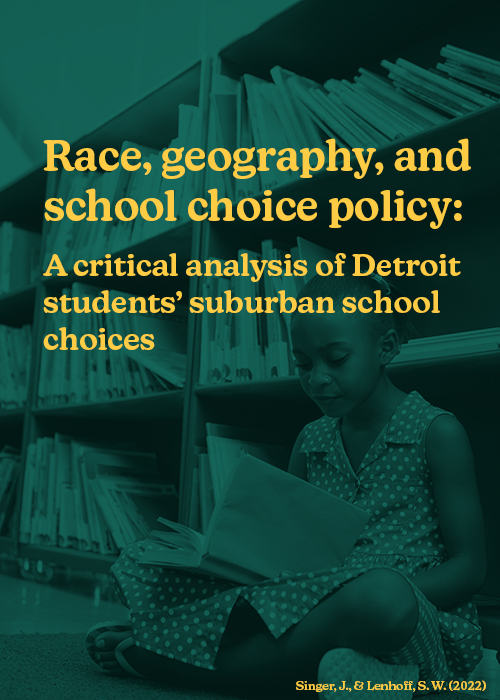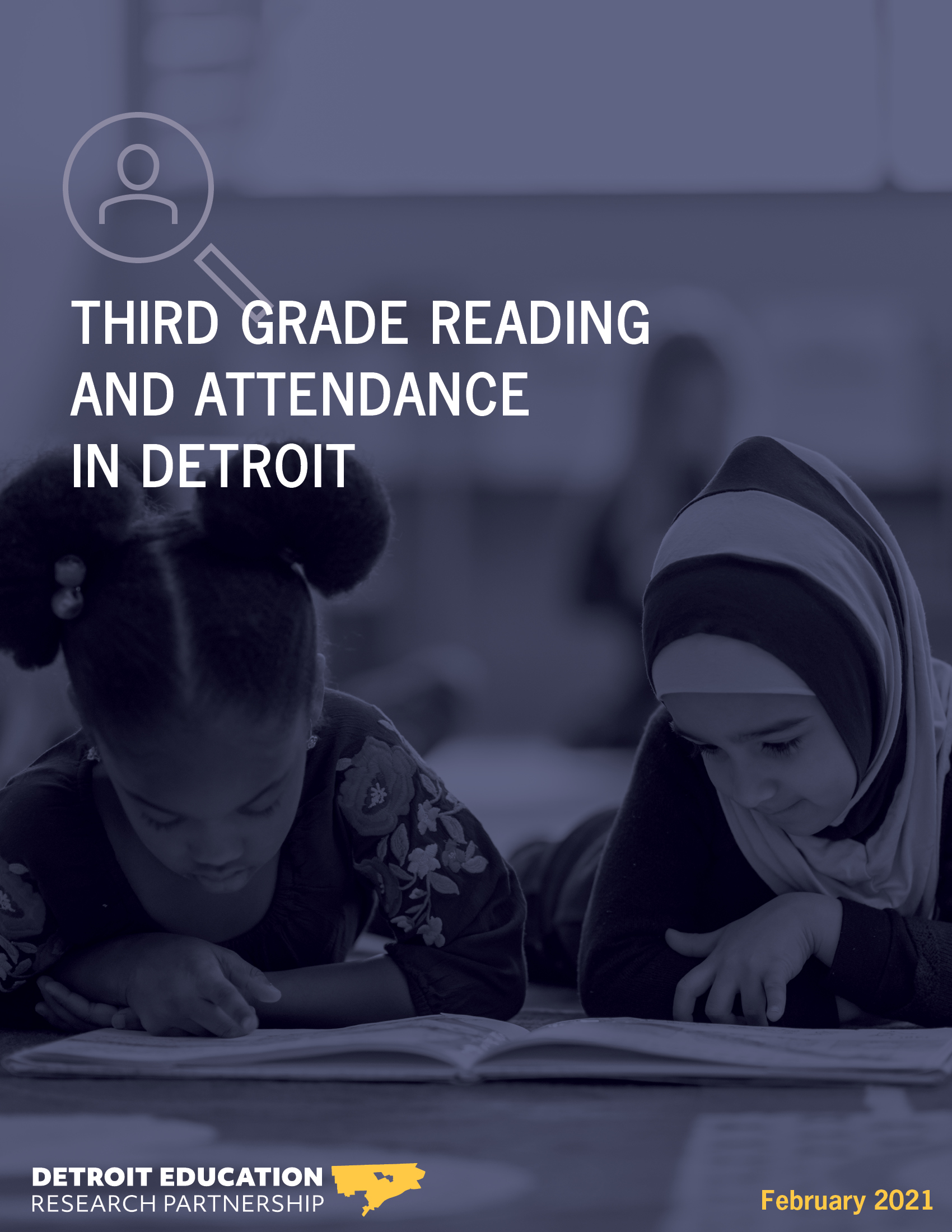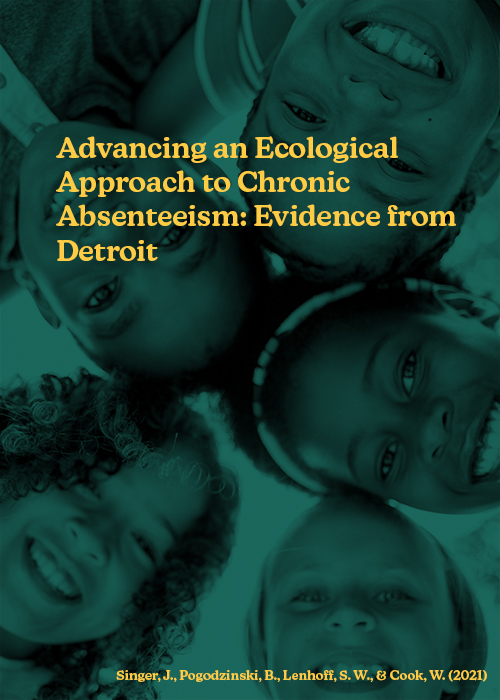Topic: Race
Detroit’s Educational Outcomes and Opportunities Across Race and Gender
Contemporary education policy is dominated by narrow representations of student data, resulting in a limited understanding of school inequalities. This study aims to show how educational outcomes and opportunities are differentially experienced when race and gender are simultaneously accounted for in Detroit. Analyzing educational outcomes and opportunities for students who live in Detroit, we examine differences by race and gender in areas such as math and reading achievement, high school graduation, chronic absenteeism, access to advanced coursework in high school, and special education.

Parent Work Schedule and Student Attendance
This study examines how parents’ employment and work schedule are associated with student attendance in school and the probability of being chronically absent. It contributes new knowledge on how workplace polices outside of schools can shape what we typically think of as school outcomes.

Participatory Action Research to Reduce Chronic Absenteeism
This is a participatory action research project designed to address chronic absenteeism and its impact on Detroit neighborhoods. With Detroit PEER support, community members have designed and carried out comparative studies to understand youth and educator perspectives on chronic absenteeism. The goal of the project is to support schools with understanding and addressing chronic absenteeism based on youth-centered, contextually specific, and neighborhood-based information.

Economic and Educational Opportunity in the Context of Neighborhood Change
Children growing up in segregated and under-resourced neighborhoods and schools have continuously faced structural inequities resulting in worse educational and economic outcomes. In highly segregated and under-resourced neighborhoods, one way that educational inequality persists is through inequitable access to resources and information through social networks. Federally sponsored housing programs have sought to address these inequities by disrupting concentrated poverty and racial segregation in neighborhoods, but one challenge of such programs has been their primary focus on housing, neglecting other neighborhood conditions and social resources. HUD’s Choice Neighborhoods Initiative (CNI) was established to address these prior limitations by strengthening community social cohesion through cross-sector collaborations. Prior research has demonstrated that social networks – one’s relationships and connections with others – could be a key driver of upward mobility for Black low-income youth. However, few studies have empirically explored how neighborhood interventions might expand or deepen the social connections of youth in ways that reduce inequality in educational opportunities. This study aims to describe and clarify the mechanisms through which a major federal housing initiative can reduce educational inequality for Black low-income youth by transforming their social networks. A second aim of this study is to examine whether key components of the CNI are implemented in ways that connect housing and school sectors to disrupt segregation, foster neighborhood and school integration, and empower residents, particularly low-income Black residents, to shape policy enactment.

Race, geography, and school choice policy: A critical analysis of Detroit students’ suburban school choices
The purpose of this study is to advance our thinking about race and racism in geospatial analyses of school choice policy. To do so, we present a critical race spatial analysis of Detroit students’ suburban school choices. To frame our study, we describe the racial and spatial dynamics of school choice, drawing in particular on the concepts of opportunity hoarding and predatory landscapes. We find that Detroit students’ suburban school choices were circumscribed by racial geography and concentrated in just a handful of schools and districts. We also find notable differences between students in different racial groups. For all Detroit exiters, their schools were significantly more segregated and lower quality than those of their suburban peers. We propose future directions for research on families’ school choices as well as school and district behavior at the intersection of race, geography, and school choice policy.

Third Grade Reading and Attendance in Detroit
Potential student retention under the Read by Grade Three Law is a critically important issue to better understand and address in Detroit. Detroit students have historically been retained at much higher rates than their suburban peers. Nearly 15% of Detroit third graders would have been subject to retention under the Third Grade Reading law had it been in effect in previous years. There is a significant relationship between third grade reading scores and chronic absenteeism.

Advancing an Ecological Approach to Chronic Absenteeism: Evidence from Detroit
Drawing on ecological systems theory to study chronic absenteeism, the authors identify the association between student, neighborhood, and school factors and chronic absenteeism in Detroit, as well as between macro-level structural and environmental conditions and city-wide chronic absenteeism rates in large U.S. cities. The authors’ findings suggest the need for coordinated, ecosystemic policy interventions that address structural and environmental barriers to attendance along with school-based efforts that more immediately support students and their families.

Unregulated Open Enrollment and Inequitable Access to Schools of Choice
In severing the link between residential address and school assignment, school choice policies have the potential to decrease school segregation and increase educational equity. Yet, this promise is undermined when school choice creates greater opportunity for those who are already privileged while limiting access to students from historically marginalized groups. This study combines data from a new survey of local open enrollment policies in Metro Detroit, student-level administrative records, and geographic data to critically analyze the local discretion provided in Michigan’s interdistrict school choice policy in relation to the goals of access to schools of choice, desegregation, and educational equity. I find that local school districts implement provisions of state policy in ways that restrict access to Black and economically disadvantaged students while creating pathways of opportunity for others. Districts are incentivized to implement these restrictions because of the inequities built into the state school funding formula and the racialized geography of Metro Detroit that is mechanized in district and county boundaries to restrict access. This study has implications for the regulation of local school choice markets and the role they play in increasing equitable public school opportunities.

Detroit’s Uniquely Challenging Context for Student Attendance
Nationwide, long-term population change, asthma rates, poverty and unemployment rates, residential vacancy rates, violent crime rates, average monthly temperature, and racial segregation for a city’s greater metropolitan area are all significantly correlated with city-wide rates of chronic absenteeism. Detroit has the highest chronic absenteeism rate in the country (about 50%), and it has a uniquely challenging context for student attendance. Among cities with 500,000 or more residents, Detroit has the highest adult asthma rate (14%), unemployment rate (about 20%), poverty rate (about 38%), violent crime rate (about 20 per 1,000 people), and residential vacancy rate (27%). In addition, it has the greatest population loss since 1970 (about 50% decline), one of the lowest average monthly temperatures (about 49° F), and is among the most segregated major metropolitan areas in the country.

Geography, School Type, and High Student Attendance in Detroit
Detroit’s high attenders missed an average of just 2 days a year and performed significantly better on ELA and math standardized tests than non-high attenders, even those missing an average of 9 days a year. Nearly 70% of Detroit’s high attenders were enrolled in “high attendance schools,” or the top third of schools by attendance rate. Just 8% of high attenders were enrolled in “low attendance schools.” Most of Detroit’s high attenders were enrolled in “commuter” charter schools downtown and in the Detroit Public Schools Community District’s application- or exam-based schools, traveling farther on average than non-high attenders to enroll in school.

Exiting Detroit for School: Inequitable Choice Sets and School Quality
Research has documented the complexity of parent-decision making within school choice marketplaces, including the ways in which individual preferences, social networks, and geography influence where parents choose to enroll their children in school. Yet, parent choices are constrained by the ways in which these dynamics intersect with existing school characteristics and locations. By constructing unique choice set “landscapes” for 194 Detroit neighborhoods, taking into account where current neighbors attend school in the city, this paper contributes new evidence on the influence of peer enrollment on school choosing, and how peer choice sets differ from students’ nearest schools. We find that parents are responsive to lower quality schools in their choice sets when choosing to exit and that choice set quality varies by race, with Black students having lower quality schools in their Detroit choice sets.

Exiting Detroit for School: Inequitable Choice Sets and School Quality
Students who exited Detroit for school had lower quality schools (test score performance, teacher and student stability, new teachers, discipline) in Detroit than students who stayed. Students who attended a non-Detroit school enrolled in schools that had, on average, higher discipline rates, more new teachers, lower teacher retention, and higher test scores than their choice sets in Detroit. The physical and cultural geography of students’ neighborhood choice sets varied dramatically across the city. Students who lived in neighborhoods where most of their neighbors went to just a few schools were less likely to exit.

Student Exit, Mobility, and Attendance in Detroit
This comprehensive report documents Detroit students' school choices, attendance, and mobility as of 2017-18. Nearly a quarter of Detroit students attended a public school in the suburbs in 2017-18. Most had previously attended school in Detroit. Students were more likely to have attended school outside the city when they had fewer city schools near where they lived, raising important policy questions about school locations, closures, and access. Seventeen percent of Detroit students switched schools between school years when they were not in a transition year. Early elementary school and 9th grade students were most likely to be movers, and more than half of all non-routine moves were among students who did not change residence, suggesting that dissatisfaction, disciplinary pushout, or other school-level issues may be contributing to mobility. More than half of students who attended school in Detroit were chronically absent, missing 10% or more of the school year. Controlling for individual student characteristics, students were more likely to be chronically absent if they attended a school with high rates of student mobility, were new to the school, commuted further to get to school, and when they lived in neighborhoods with higher asthma rates.



